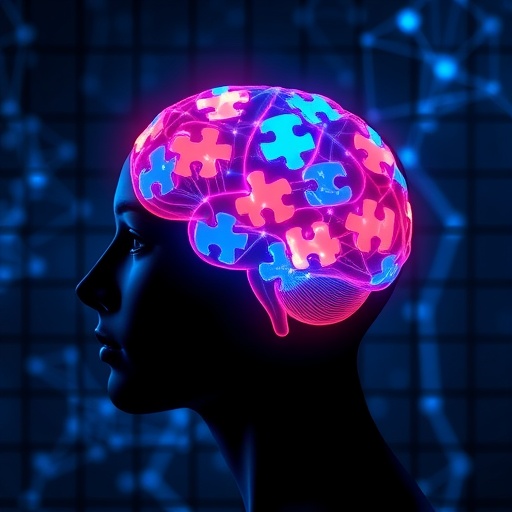In recent years, the intricate relationship between brain activity alterations and neurochemical dynamics in autism spectrum disorder (ASD) has emerged as a critical frontier in neuroscience. The groundbreaking study published by Grumbach et al. in Nature Communications (2025) advances this understanding by revealing how local neuronal activity variations in individuals with autism not only correspond with neurotransmitter properties but also align with ketamine-induced changes in brain function. This multifaceted exploration offers a transformative window into how subtle shifts in neurochemical balance can manifest as distinct neural signatures in ASD, thereby reshaping the landscape of neuropsychiatric research and potential therapeutic interventions.
Central to this study is the elucidation of local brain activity patterns measured through advanced neuroimaging techniques, which capture the delicate fluctuations in cortical excitability across various brain regions. The researchers employed a combination of functional magnetic resonance imaging (fMRI) and magnetic resonance spectroscopy (MRS) to correlate these localized activity alterations with biochemical profiles of key neurotransmitters, including glutamate and gamma-aminobutyric acid (GABA). This dual-modal approach enabled the team to transcend the limitations of singular measurement modalities, thus offering a more holistic view of the underlying neurophysiological disturbances characteristic of autism.
One of the study’s most compelling elements is its focus on the excitation/inhibition (E/I) balance—a fundamental principle dictating neural circuit function. Dysregulation of this E/I balance, particularly an overexcitation or underinhibition within cortical microcircuits, has long been hypothesized to underpin a variety of neurodevelopmental disorders, including ASD. Grumbach and colleagues provide empirical evidence indicating that individuals with autism exhibit consistent alterations in these neurotransmitter concentrations, which in turn manifest as measurable changes in local brain activity. This discovery intensifies the dialogue about how synaptic and cellular-level dysfunctions translate into the cognitive and behavioral phenotypes observed clinically.
Adding to the novelty, the team explored how ketamine, a well-known NMDA receptor antagonist with rapid-acting antidepressant properties, modulates these brain activity patterns. By administrating subanesthetic doses of ketamine and mapping the ensuing changes, the research delineated a striking parallel between ketamine-induced neural modulations and the naturally occurring activity shifts found in ASD patients. This pharmacological probe serves a dual purpose: not only does it validate the neurochemical hypotheses surrounding excitatory and inhibitory neurotransmission, but it also opens a promising avenue for novel interventions aimed at normalizing dysfunctional signaling pathways in the autistic brain.
The methodological rigor of the study is noteworthy. The sample pool included a well-characterized cohort of individuals diagnosed with autism spectrum disorder, along with matched neurotypical controls, enhancing the validity and specificity of the findings. Importantly, the researchers accounted for a range of confounding factors, such as age, sex, and co-morbid conditions, ensuring that the observed correlations were robust and not artifacts of extraneous variables. The integration of electrophysiological markers with metabolite concentrations further underscores the sophisticated analytical framework deployed.
Underlying the local activity changes is the notion that neurotransmitter systems function not in isolation but as parts of a dynamic interactive network. The researchers observed regional specificity in the altered patterns, with certain cortical areas demonstrating a higher susceptibility to imbalances in glutamatergic and GABAergic signaling. This spatial heterogeneity challenges simplistic models of ASD as a globally hyper- or hypoactive brain state, suggesting instead a nuanced picture where localized microcircuit dysfunctions collectively contribute to the disorder’s heterogeneous manifestation.
On the molecular level, the study’s findings implicate NMDA receptor functionality as a critical nexus point. Ketamine’s action on the NMDA subtype of glutamate receptors mirrors alterations seen in the autistic brain, implying aberrant receptor-mediated signaling as a core pathological feature. This insight unifies disparate strands of research linking synaptic plasticity deficits with ASD symptomatology and opens new vistas for therapeutic targeting aimed at restoring homeostatic plasticity.
Equally fascinating is the study’s demonstration of translational relevance. By elucidating how ketamine reshapes neural activity in patterns resembling those found in ASD, Grumbach et al. highlight a potential pharmacotherapeutic pathway that could modulate circuit dysfunctions underlying core symptoms. This aligns with emerging paradigms leveraging psychedelics and NMDA modulators in precision psychiatry, although much remains to be explored regarding long-term efficacy and safety in neurodevelopmental contexts.
Importantly, the research also raises critical questions about developmental trajectories. Given that neurotransmitter systems and brain activity patterns both evolve dynamically from childhood through adulthood, the static snapshots offered by current neuroimaging necessitate complementary longitudinal studies. Such research is vital for understanding whether these observed neurotransmitter-linked activity alterations are causes, consequences, or compensatory responses within the autistic brain’s developmental milieu.
The implications for diagnostic innovation cannot be overstated. Traditional behavioral assessments, while indispensable, often fall short of capturing the underlying neurobiological heterogeneity in autism. Biomarkers derived from local brain activity changes and accompanying neurotransmitter profiles, as delineated in this study, hold promise for more objective, mechanistically grounded diagnostic tools that could stratify patient subtypes and inform individualized treatment planning.
From an analytical standpoint, the study employs sophisticated statistical frameworks, including multivariate pattern analysis and machine learning classifiers, to uncover subtle correlations and predictive patterns within the complex datasets. This approach exemplifies the power of computational neuroscience in peeling back layers of neural complexity, providing actionable insights that bridge bench and bedside.
The broader neuroscientific community will find the study’s approach and findings catalytic in advancing the dialogue on brain neurochemistry’s role in neurodevelopmental disorders. By integrating multidisciplinary perspectives—ranging from neuropharmacology and functional imaging to computational modeling—the paper sets a new benchmark for interdisciplinary collaboration.
In sum, Grumbach et al.’s work is a tour de force in dissecting the biochemical underpinnings of autism-linked brain activity. It reframes the conversation around ASD pathophysiology, emphasizing the intricate dance between neurotransmitter systems and local neural activity. Moreover, it paves the way for innovative interventions targeting these molecular pathways, carrying the tantalizing prospect of reshaping clinical outcomes for millions affected worldwide.
As research accelerates, future studies will likely expand on these findings by incorporating genetic data, longitudinal monitoring, and diverse pharmacological probes to unravel the full complexity of ASD neurobiology. The integration of such data layers may eventually culminate in tailored, neurochemically informed therapies that transcend symptomatic treatment and address root causes.
Through this lens, the study serves as a beacon of hope, illuminating the path toward a more nuanced, scientifically grounded understanding of autism. As the neuroscience field evolves, uncovering these biochemical correlates of brain activity changes promises to not only deepen fundamental knowledge but also inspire a new generation of targeted, effective treatments designed to improve lives profoundly.
Subject of Research: Neural activity alterations and neurotransmitter properties in autism spectrum disorder, and their modulation by ketamine.
Article Title: Local activity alterations in individuals with autism correlate with neurotransmitter properties and ketamine-induced brain changes.
Article References:
Grumbach, P., Kasper, J., Hipp, J.F. et al. Local activity alterations in individuals with autism correlate with neurotransmitter properties and ketamine-induced brain changes. Nat Commun 16, 8248 (2025). https://doi.org/10.1038/s41467-025-63857-6
Image Credits: AI Generated
Tags: autism spectrum disorder researchbrain activity and neurotransmitterscortical excitability fluctuationsfMRI and MRS in neuroscienceglutamate and GABA in autismketamine effects on brain functionlocal neuronal activity variationsneurochemical balance in autismneuroimaging techniques in autismneurophysiological disturbances in ASDneuropsychiatric therapeutic interventionstransformative insights in neuroscience





